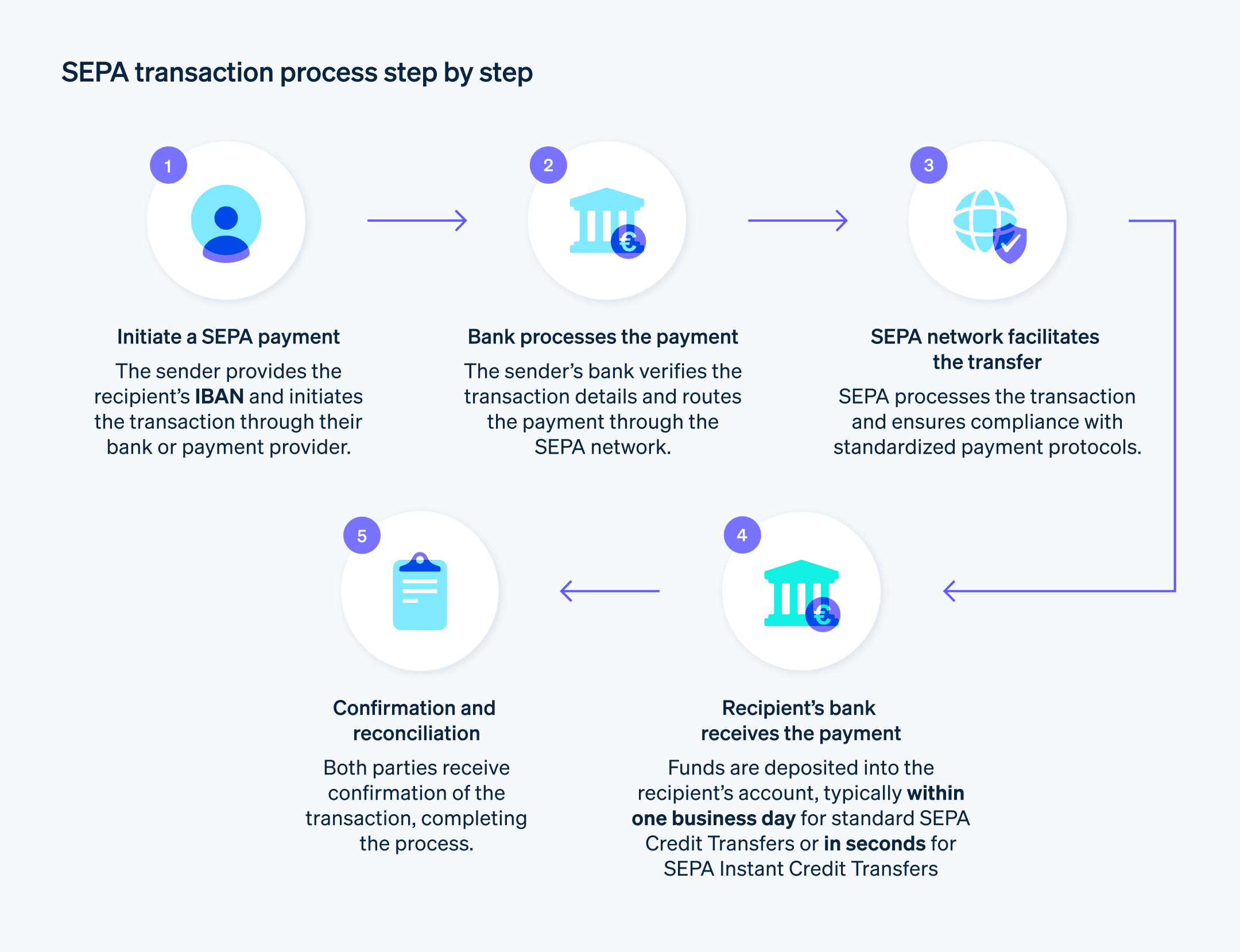对于欧洲的企业和客户来说,SEPA 转账是支付处理的重要组成部分,它支持以欧元计价的支付实现无缝跨境交易。
单一欧元支付区 (SEPA) 是一个支付框架,它使企业和个人能够在 36 个参与国家/地区之间发送和接收欧元电子付款,其便捷程度与国内交易相同。
如果您正在处理经常性付款、供应商付款或水电费,您需要了解 SEPA 支付计划如何改善您的财务运营并降低成本。在本文中,我们将介绍什么是 SEPA、SEPA 转账的运作方式以及企业如何使用它们轻松进行跨境支付。
本文内容
- 什么是 SEPA?
- SEPA 国家/地区列表
- SEPA 是如何运作的?
- 如何进行 SEPA 支付
- SEPA 付款需要多长时间?
- 我的企业需要 SEPA 账户吗?
- 非 SEPA 企业是否应该在欧洲开设银行账户?
- Stripe Payments 如何提供帮助
什么是 SEPA?
SEPA 代表单一欧元支付区 (SEPA),这是一项简化无现金支付并在欧盟成员国之间创建交易一致性的倡议。SEPA 由欧洲支付委员会 (EPC) 设立,受欧洲中央银行监管,支持个人和企业在相同条件下进行国内和跨境支付,不因国界而受到限制。
SEPA 目前每年处理大约 500 亿笔交易,包括 SEPA 贷记转账、SEPA 直接借记交易和借记卡支付。SEPA 于 2008 年 1 月首次开始运营,推出了 SEPA 贷记转账,随后于 2009 年 11 月推出了直接借记和借记卡。
原则上,SEPA 的目标与美国的 ACH 和 Fedwire 网络相似:在金融机构之间促进标准化交易,以为所有用户提供一致的框架。在 SEPA 成立之前,其成员国分散在各自的国内市场中,导致跨境交易处理时产生阻力。跨境交易速度较慢,成本高昂,并且需要复杂的银行详细信息。
SEPA 的建立涉及制定共享的标准、程序和转移资金所需的基础设施,这些标准和基础设施已被每个成员国采纳。除了最小化账户之间资金转移的障碍外,SEPA 还带来了降低在欧盟及周边国家转移资本相关费用的额外好处。SEPA 促进了其运营地区的经济增长,为全球消费者和企业提供了便利。

SEPA 国家/地区列表
截至 2025 年 5 月,SEPA 区域涵盖 41 个国家/地区,其中包括多个非欧盟成员国。
SEPA 是如何运作的?
SEPA 的标准化支付方案支持对 SEPA 区域内任何以欧元计价的银行账户进行直接借记。这也意味着在任何成员国内进行国内支付和跨境交易同样简单、经济实惠。SEPA 使账户持有人和支付服务提供商 (PSP) 能够接收直接存款,并从其银行账户中发起电子支付,即使在其他国家/地区旅行时也是如此。
对于消费者交易,SEPA 支持企业使用 SEPA 直接借记计划从成员国内的客户账户中借记。
SEPA 由四个支付处理方案组成:
- SEPA 贷记转账:SEPA 成员国的标准一次性付款
- SEPA 即时贷记转账:最高 100000 欧元的实时即时支付
- SEPA 直接贷记核心:主要用于经常性付款,例如水电费、供应商付款和贷款偿还
- SEPA 企业对企业直接借记:类似于 SEPA 直接贷记核心,但仅用于具有更严格授权要求的 B2B 交易
如何进行 SEPA 支付
SEPA 区域内的每个银行账户都被分配一个国际银行账号 (IBAN) 和银行识别代码 (BIC),这是欧洲相当于美国银行账号的标识符。类似于国内通过 ACH 和 Fedwire 网络进行转账需要双方的银行账户和路径号码以完成资金转移,SEPA 转账需要所有参与交易的欧洲账户的 IBAN 标识代码。
以下是不同类型的 SEPA 转账的工作概述:
SEPA 贷记转账:SEPA 贷记转账是两个银行之间的一次性资金转移,这两个银行都必须有 IBAN 代码。这些转账以欧元进行,通常用于 SEPA 国家中的消费者购买。如果您是一家不在 SEPA 区域内的企业,则无法使用这种转账方式,因为发起和接收的金融机构必须位于 SEPA 国家。
SEPA 即时贷记转账:虽然大多数账户之间的转账需要提交转账请求,并等待数小时到数天才能结算,但 SEPA Instant 允许实时转账,金额高达 100,000 欧元。使用这种方式,任何两位账户持有人可以在 SEPA 区域内的任何时间、任何一天完成以欧元计价的交易,并立即处理。99% 的 SEPA 即时贷记转账在五秒内完成,并可以通过智能手机进行操作。
SEPA 直接借记:直接借记是外国(非欧盟)企业与 SEPA 内账户交互的最常见方式。对于 Stripe 用户,SEPA 直接借记是一种可重用的通知型支付方式。这意味着它是一种可以与客户内部关联并由企业以授权的方式重复使用的支付方式。它也是一种延迟通知型支付方式,这意味着交易的成功或失败仅在交易处理完成后才能得知,处理时间可能需要几天。

SEPA 付款需要多长时间?
大多数 SEPA 支付在发起后的一天内结算。但是,处理时间取决于所使用的付款方案:
- SEPA 贷记转账:在工作日 24 小时内结算。
- SEPA 即时付款:在 10 秒内完成,24/7 全天候可用。
- SEPA 直接借记交易:通常需要 3 到 6 个工作日进行结算,尤其是在处理来自非 SEPA 地区的跨境支付时。
我的企业需要 SEPA 账户吗?
企业不需要单独的 SEPA 银行账户即可使用 SEPA 网络处理支付。SEPA 本身不是一家金融机构(即,它不发行或维护自己的账户),而是一个由成员国的银行使用的系统。如果您的企业银行账户拥有 IBAN 号码,并且您的企业位于 SEPA 成员国,则您已经可以访问 SEPA 网络及其内部的产品。
不在 SEPA 成员国的企业,包括位于美国的企业,仍可能能够使用 SEPA 的某些方面,特别是与消费者交易相关的支付,这些交易来自于居住在 SEPA 成员国的客户。
非 SEPA 企业是否应该在欧洲开设银行账户?
如果您的企业在欧元区国家/地区运营或在 SEPA 地区有子公司,开设本地 SEPA 账户可能有好处。
通过基于 SEPA 的银行账户,企业可以快速、低成本地获得 SEPA 转账、更便宜的现金提取和更低的跨境交易费用。
作为 Stripe 用户,您可以从 Stripe 管理平台添加 SEPA 直接借记和其他支付方式,而无需更改代码。
Stripe Payments 如何提供帮助
Stripe Payments 提供一体化的全球支付解决方案,帮助各种商家(从初创公司到全球企业)在全球范围内接受线上和线下付款。
Stripe Payments 可以帮您:
- 优化结账体验: 通过预构建的支付用户界面、超过 125100 种支付方式以及 Stripe 构建的钱包 Link,营造顺畅的客户体验,并节省数千个工程小时。
- 更快地拓展新市场: 借助跨境支付选项,触达全球客户,降低多币种管理的复杂性与成本,业务覆盖 195 个国家/地区,支持超过 135 种货币。
- 实现线下与线上付款一体化: 整合线上与线下渠道,打造一体化商务体验,实现个性化互动、奖励客户忠诚度并提升收入。
- 优化支付性能: 通过一系列可定制、易于配置的支付工具提升收入,包括无代码的欺诈保护功能与提高授权率的高级功能。
- 依托灵活可靠的平台加速业务增长: 采用专为弹性扩展设计的平台架构,提供 99.999% 正常运行时间与业界领先的可靠性保障。
了解关于 Stripe Payments 如何为您的线上与线下付款提供支持的更多信息,或立即开始使用。
本文中的内容仅供一般信息和教育目的,不应被解释为法律或税务建议。Stripe 不保证或担保文章中信息的准确性、完整性、充分性或时效性。您应该寻求在您的司法管辖区获得执业许可的合格律师或会计师的建议,以就您的特定情况提供建议。